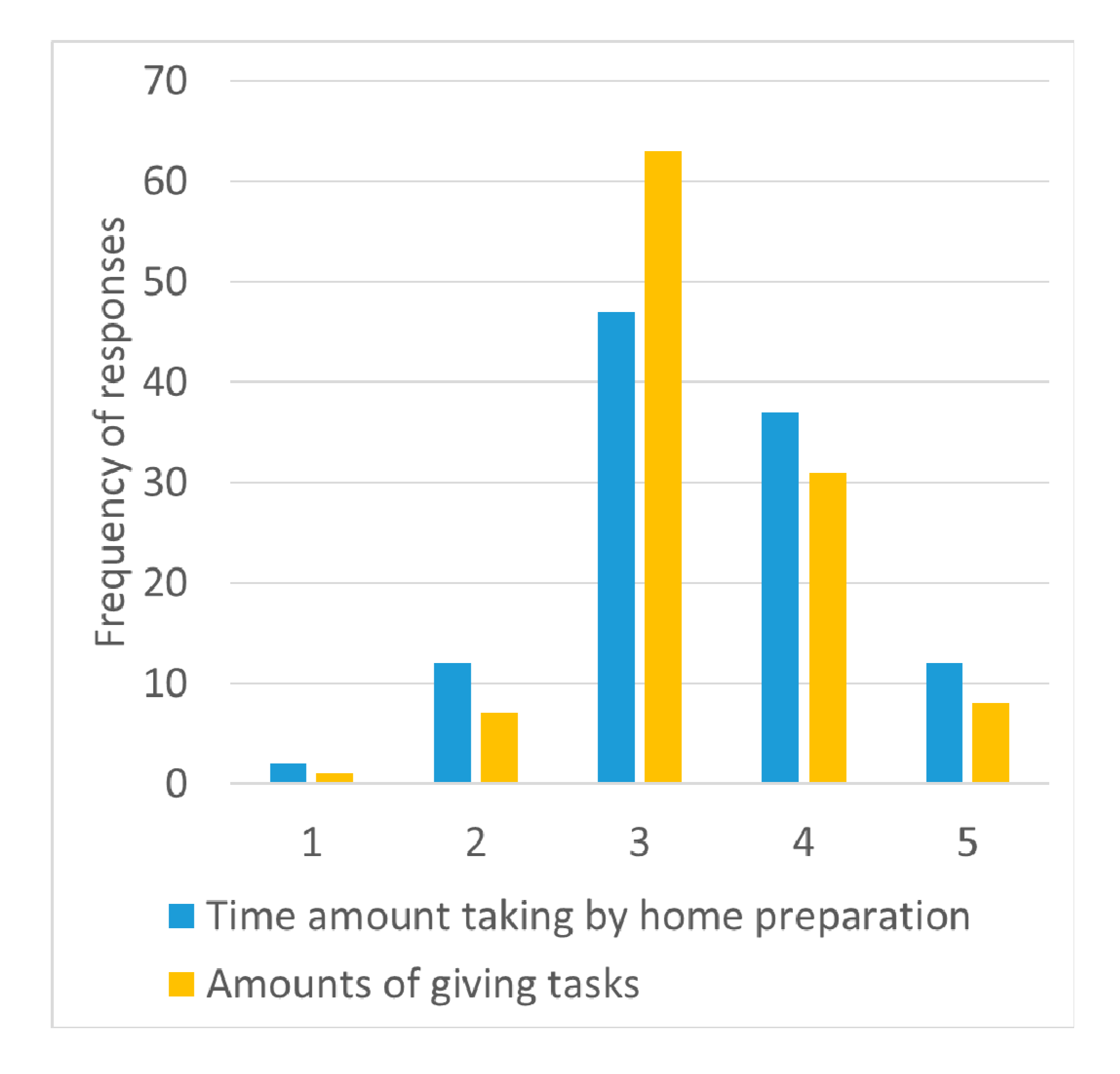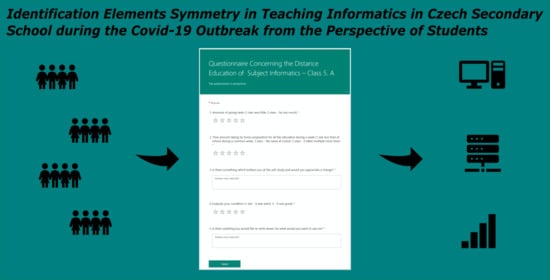Identification Elements Symmetry in Teaching Informatics in Czech Secondary School during the Covid-19 Outbreak from the Perspective of Students
Abstract
:1. Introduction
2. Teaching the Subject Informatics
2.1. Sophomore Year
2.2. Fifth Year
2.3. Sixth Year
2.4. The Informatics and Computing Technique Seminar in the Seventh Year
2.5. The Informatics and Computing Technique Seminar in the Eighth Year
3. MS Teams
4. Students’ Attitude to Teaching Informatics during the Covid-19 Outbreak
4.1. Methodology
- Questionnaire Concerning the Distance Education of Subject Informatics—Class X
- Amounts of giving tasks (1 star very little, 5 stars—far too much)
- Time amount taking by home preparation for all the education during a week (1 star less than at school during a common week, 3 stars—the same at school, 5 stars—it takes multiple more time)
- Is there something which bothers you at the self-study and would you appreciate to change?
- Evaluate your condition (1 star—awful, 5—great)
- Is there anything you would like to write down; for what would you want to ask me?
4.2. Results
5. Conclusions
Author Contributions
Funding
Acknowledgments
Conflicts of Interest
References
- Cleveland-Innes, M. Blended Learning. In An Introduction to Distance Education: Understanding Teaching and Learning in a New Era; Taylor & Francis: Northampton, UK, 2010; p. 165. ISBN 978-0-415-99598-6. [Google Scholar]
- COVID-19 Educational Disruption and Response; UNESCO: Paris, France, 2020.
- Oktaviani, M.; Zulfa, V.; Elmanora, E. What platform makes students enjoy the learning during covid-19 pandemic? Proc. Umsaurabaya 2020, 1, 102–107. [Google Scholar]
- Nilam, D.; Sari, W.P.; Mulu, M. Explorative study on the application of learning model in virtual classroom during Covid-19 pandemic at the school of Yogyakarta Province. Proc. Umsaurabaya 2020. Available online: http://journal.um-surabaya.ac.id/index.php/Pro/article/view/5951 (accessed on 14 September 2020).
- Naila, I.; Sadida, Q. The Effects of Online Learning on Pre-Service Teachers Social Facilitation during Covid-19 Pandemic. Proc. Umsaurabaya 2020. Available online: http://103.114.35.30/index.php/Pro/article/view/5968 (accessed on 14 September 2020).
- Prestiadi, D. Effectiveness of e-learning implementation as a distance learning strategy during coronavirus disease (covid-19) pandemic. Proc. Umsaurabaya 2020. Available online: http://journal.um-surabaya.ac.id/index.php/Pro/article/view/5950 (accessed on 14 September 2020).
- Gaggi, O.; Kolasinska, A.B.; Mirri, S.; Prandi, C. The new classmate: An exploration of how CoVid-19 affected primary schools’ activities in Italy. In Proceedings of the 6th EAI International Conference on Smart Objects and Technologies for Social Good, Brussel, Belgium, 14–16 September 2020; Association for Computing Machinery: New York, NY, USA, 2020; pp. 36–41. [Google Scholar]
- Carius, A.C. Teaching Practices in Mathematics During COVID-19 Pandemic: Challenges for Technological Inclusion in a Rural Brazilian School. Am. Sci. Res. J. Eng. Technol. Sci. 2020, 72, 35–43. [Google Scholar]
- Yudina, N. Distance E-Learning Around the Turn of the New Decade; Global Society of Scientific Research and Researchers: Amman, Jordan, 2020. [Google Scholar]
- Lassoued, Z.; Alhendawi, M.; Bashitialshaaer, R. An Exploratory Study of the Obstacles for Achieving Quality in Distance Learning during the COVID-19 Pandemic. Educ. Sci. 2020, 10, 232. [Google Scholar] [CrossRef]
- Friedman, C. Students’ Major Online Learning Challenges amid the COVID-19 Pandemi c. J. Pedagog. Sociol. Psychol. 2020, 1, 45–52. [Google Scholar]
- Molchanova, E.; Kovtoniuk, K.; Savych, O. Kyiv National Economic University named after Vadym Hetman Covid-19 Presents New Challenges and Opportunities to Higher Education. Rev. Romaneasca Pentru Educ. Multidimens. 2020, 12, 168–174. [Google Scholar] [CrossRef]
- Da Silva, O.; Sidmar, S.O.S.F.; de Liveira-Siveira, O. Educar na Incerteze e na Urgencia: Implicatacoes do Ensiono Remoto ao Fazer Docente e a Reinvencao da Sala de Aula. Interfaces Científicas-Educação 2020, 10, 25–40. [Google Scholar]
- Berkova, A.J.; Nemec, R. Teaching Theory of Probability and Statistics during the Covid-19 Emergency. Symmetry 2020, 12, 1577. [Google Scholar] [CrossRef]
- Rojabi, A.R. Exploring EFL Students’ Perception of Online Learning via Microsoft Teams: University Level in Indonesia. Eng. Lang. Teach. Educ. J. 2020, 3, 163–173. [Google Scholar]
- Hai-Jew, S. Evaluating “MS Teams” for Teaching and Learning. C2C Digit. Mag. 2020, 1, 7. [Google Scholar]
- Microsoft Teams. Available online: https://www.microsoft.com/en-us/microsoft-365/microsoft-teams/group-chat-software (accessed on 14 September 2020).
- Microsoft Teams měly v Evropě Opět Výpadek. Microsoft Zaznamenal o 775% Větší Zájem o Cloudové Služby. Available online: https://www.zive.cz/clanky/microsoft-teams-mely-v-evrope-opet-vypadek-microsoft-zaznamenal-o-775-vetsi-zajem-o-cloudove-sluzby/sc-3-a-203183/default.aspx (accessed on 14 September 2020).
- Microsoft Teams at 3: Everything You Need to Connect with Your Teammates and be More Productive. Available online: https://www.microsoft.com/en-us/microsoft-365/blog/2020/03/19/microsoft-teams-3-everything-you-need-connect-teammates-be-more-productive/ (accessed on 14 September 2020).
- Microsoft Teams Has Seen A 775% Rise in Users in Italy Because of COVID-19. Available online: https://www.forbes.com/sites/martingiles/2020/03/30/microsoft-cloud-service-775-percent-rise-covid-19/#1e853cad6862 (accessed on 14 September 2020).
- Microsoft Teams Raketově Rostou. Mají 75 Milionů Uživatelů Denně. Available online: https://www.zive.cz/clanky/microsoft-teams-raketove-rostou-maji-75-milionu-uzivatelu-denne/sc-3-a-203680/default.aspx (accessed on 14 September 2020).
- Microsoft Teams Education. Available online: https://www.microsoft.com/en-us/microsoft-365/microsoft-teams/education (accessed on 14 September 2020).






| Gymnasium | Elementary/Secondary School | Age of the Student |
|---|---|---|
| Primus (Freshman year) | 6th class of the elementary school | 11 |
| Secundus (Sophomore year) | 7th. class of the elementary school | 12 |
| Tertius (Third year) | 8th class of the elementary school | 13 |
| Quartus (Fourth year) | 9th class of the elementary school | 14 |
| Quintus (Fifth year) | 1st year of the secondary school | 15 |
| Sextus (Sixth year) | 2nd year of the secondary school | 16 |
| Septimus (Seventh year) | 3rd year of the secondary school | 17 |
| Octavus (Eighth year) | 4th year of the secondary school | 18 |
Publisher’s Note: MDPI stays neutral with regard to jurisdictional claims in published maps and institutional affiliations. |
© 2020 by the authors. Licensee MDPI, Basel, Switzerland. This article is an open access article distributed under the terms and conditions of the Creative Commons Attribution (CC BY) license (http://creativecommons.org/licenses/by/4.0/).
Share and Cite
Nemec, R.; Jahodova Berkova, A.; Hubalovsky, S. Identification Elements Symmetry in Teaching Informatics in Czech Secondary School during the Covid-19 Outbreak from the Perspective of Students. Symmetry 2020, 12, 1768. https://0-doi-org.brum.beds.ac.uk/10.3390/sym12111768
Nemec R, Jahodova Berkova A, Hubalovsky S. Identification Elements Symmetry in Teaching Informatics in Czech Secondary School during the Covid-19 Outbreak from the Perspective of Students. Symmetry. 2020; 12(11):1768. https://0-doi-org.brum.beds.ac.uk/10.3390/sym12111768
Chicago/Turabian StyleNemec, R., A. Jahodova Berkova, and S. Hubalovsky. 2020. "Identification Elements Symmetry in Teaching Informatics in Czech Secondary School during the Covid-19 Outbreak from the Perspective of Students" Symmetry 12, no. 11: 1768. https://0-doi-org.brum.beds.ac.uk/10.3390/sym12111768











